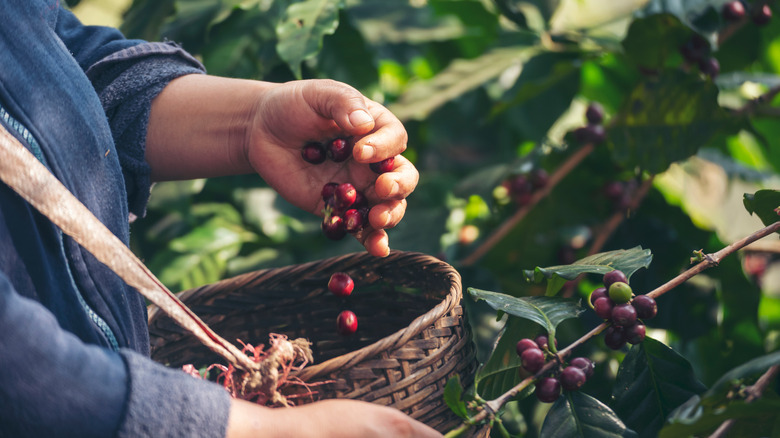Why 'U.S.' Coffee Doesn't Really Exist
For those who need a steamy cup of joe before they can even peel their eyelids open, coffee beans are a prized possession. Coffee isn't something that will be forgotten on the grocery list if it's the first thing reached for in the morning. For many, the only thing to look out for when snagging a bag of coffee at the store is that it's not decaf. Some may feel that supporting local farms and businesses should always be a priority when feasible, but java lovers are forced to reach for an imported bag when it comes to those magic beans. So drinking coffee grown in the U.S. often isn't an option.
The bold taste of different coffee beans depends on a variety of factors, one being where they were grown. Top-quality arabica beans, for example, flourish 15 degrees from the equator, says Thrillist. That's a ways away from the U.S. Coffee may be able to keep us going throughout the workday, but as a crop, it's not the most endurant. It's a rather tropical crop and will die within hours if faced with colder weather conditions, but it also can't handle too much heat. The temperamental nature of the crop doesn't mesh well with U.S. soil.
Even coffee grown in the U.S. isn't native to the country
Coffee beans — which come from a cherry-like fruit, according to The Roasterie – thrive in equatorial climates not only due to the temperatures but the consistent rainfalls as well. Areas that successfully grow coffee beans take on between 40 and 60 inches of rain, says Thrillist, whereas some areas in the states only experience 15 inches or so of rain each year. It wasn't until recently that coffee beans got comfortable on North American land.
According to World Atlas, California and Hawaii are the only parts of the U.S. where people grow coffee commercially. According to a post by a coffee roaster and barista on Imgur, coffee grown in the USA represents a very small portion of the coffee you'll find for sale in the U.S. Traditionally, the coffee that Americans consume has journeyed from different areas of the world and is named based on the location of origin. Farming expert Mark Gaskell believed the coffee plant could flourish in California, despite the lack of rain (via NPR), and he was certainly onto something. The Golden State is now home to more than 30 farms bringing Americans coffee trees, but the crops are still native to countries of different climates. Geisha coffee, for example, was born in the Gori Gesha Forest of Ethiopia (via Barista Magazine) and is being grown in California thanks to Frinj Coffee.
Of course, if we were able to grow more coffee locally, we might reduce some of the other problems presented by our obsessive coffee habits, which include deforestation, high carbon footprint, and poor conditions for workers, according to the New York Times.

